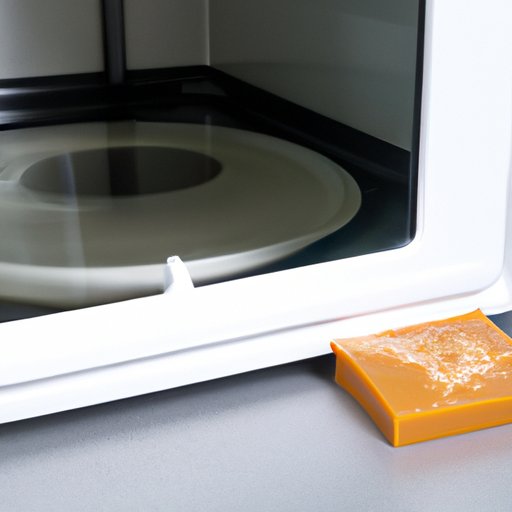Introduction
For many of us, the microwave is an essential tool in the kitchen that we use every day. However, frequent use can lead to a buildup of food stains and unpleasant odors that can be tough to remove. Keeping your microwave clean not only helps it look nicer, but it also ensures that it functions efficiently and safely. In this article, we’ll explore the best practices for cleaning microwaves, from professional tips and tricks to DIY solutions you can use with ingredients you already have in your kitchen.
The Ultimate Guide to a Sparkling Clean Microwave: Tips & Tricks from the Pros
Professional cleaning services have a wealth of experience when it comes to tackling tough microwave stains and odors. One of their top tips is to use steam to loosen dirt and grime – simply fill a microwave-safe bowl with water and microwave on high for a few minutes. The resulting steam will help soften food stains and odors, making them easier to wipe away. Vinegar is another useful tool in the arsenal of microwave cleaners. When mixed with water and heated in the microwave, the acid in vinegar helps cut through grease and grime. Baking soda is another common ingredient that can be used to remove odors and stains.
5 Super Easy Steps to Clean Your Microwave and Make it Look Brand New Again
If you’re looking for a simple, easy-to-follow process for cleaning your microwave, look no further. Here are five steps you can follow to get your microwave looking and smelling like new:
- First, remove any loose debris from the microwave – this could be food crumbs or liquid spills.
- Next, take a microwave-safe bowl and fill it with water. Add a tablespoon of vinegar to the bowl to help cut through any greasy stains.
- Microwave the bowl on high for five minutes, or until the water starts boiling and releasing steam.
- Once the bowl has cooled down, use a damp cloth or sponge to wipe down the inside of the microwave, making sure to get into all the corners and crevices.
- Finally, use a dry cloth or paper towel to wipe down the microwave and remove any leftover moisture.
It’s important to note that you should never use abrasive cleaning tools like steel wool or abrasive sponges, as these can scratch the surface of your microwave and create more problems than they solve.
Clean Your Microwave with Ingredients You Already Have in Your Kitchen: A DIY Guide
If you prefer to use natural ingredients in your cleaning routine, there are many options to choose from when it comes to cleaning your microwave. One popular method is to use lemon – simply slice a lemon in half, squeeze some of the juice out, and place the lemon halves in a bowl of water. Microwave the bowl on high for five minutes to release the lemony steam, which will help break down stains and odors. Alternatively, you can combine baking soda and water to make a paste that can be applied to tough stains. Simply rub the paste onto the stained areas, leave it for a few minutes, and then wipe it away with a damp cloth.
Keep Your Microwave Spotless: The Dos and Don’ts of Microwave Cleaning
When cleaning your microwave, there are a few important things to keep in mind. First and foremost, never use harsh chemicals like bleach or ammonia, as these can damage the interior of your microwave and even make it unsafe to use. Instead, stick to natural ingredients or gentle cleaning agents like dish soap. You should also avoid using metal utensils or containers in the microwave, as these can cause sparking and damage the microwave’s interior. If you’re unsure whether a particular material is microwave-safe, it’s always better to err on the side of caution and avoid using it in the microwave.
Say Goodbye to Stains and Odors: A Comprehensive Guide to Cleaning Your Microwave
To sum up, there are many effective ways to clean your microwave, from professional tips and tricks to DIY solutions you can create with ingredients from your kitchen. Whether you prefer the gentle touch of natural cleaners or the power of steam and vinegar, there is a method that will work for you. Remember to follow the dos and don’ts of microwave cleaning, avoid harsh chemicals and abrasive tools, and always read the manufacturer’s instructions before attempting any cleaning. With a little bit of time and effort, you can have a sparkling clean microwave that will look and function like new.
Conclusion
Cleaning your microwave may not be the most glamorous chore, but it’s an important one that can have a big impact on the health and safety of your kitchen. With the tips, tricks, and DIY solutions we’ve explored in this article, you can confidently tackle tough stains and stubborn odors, and keep your microwave looking and working like new.
